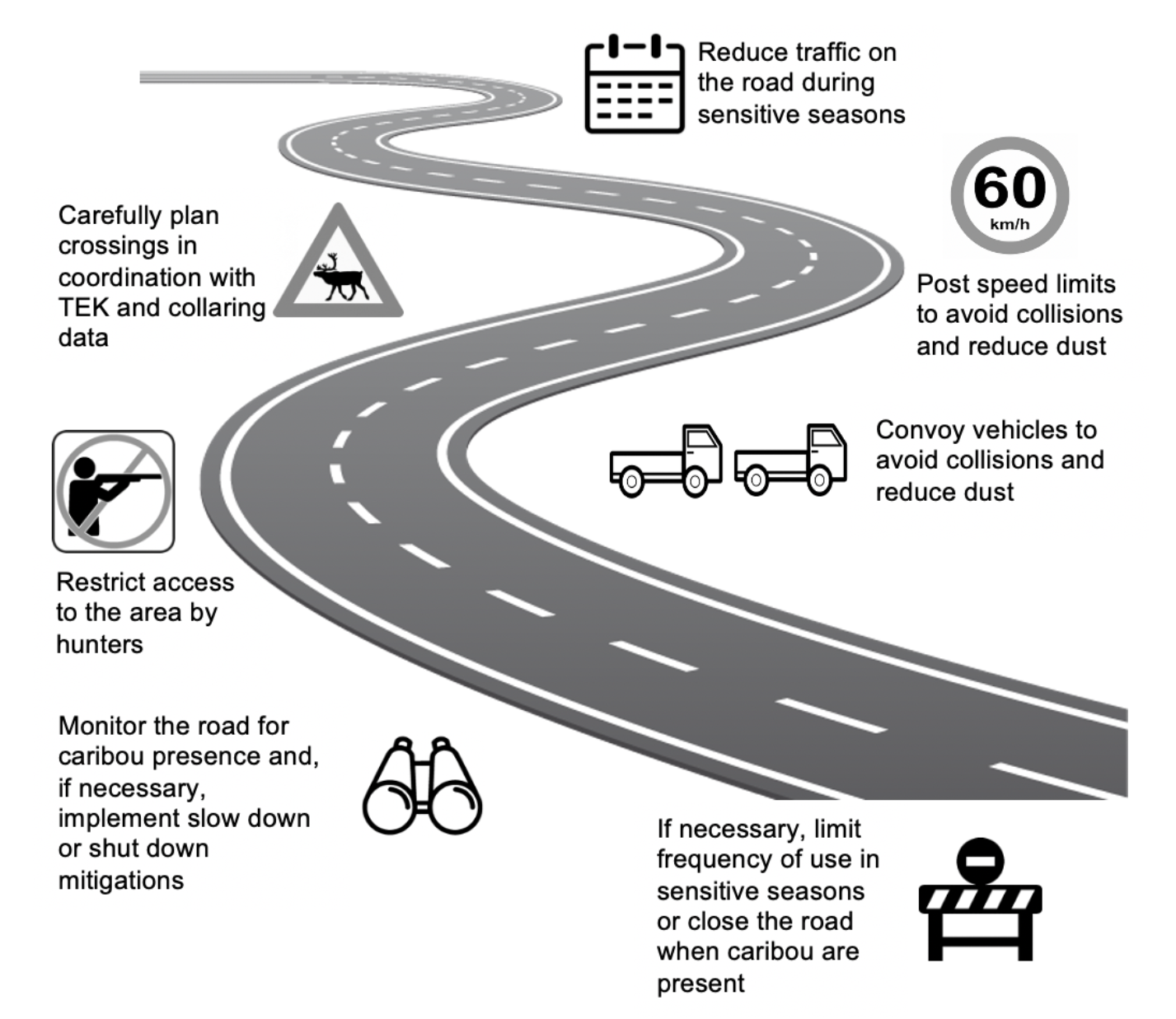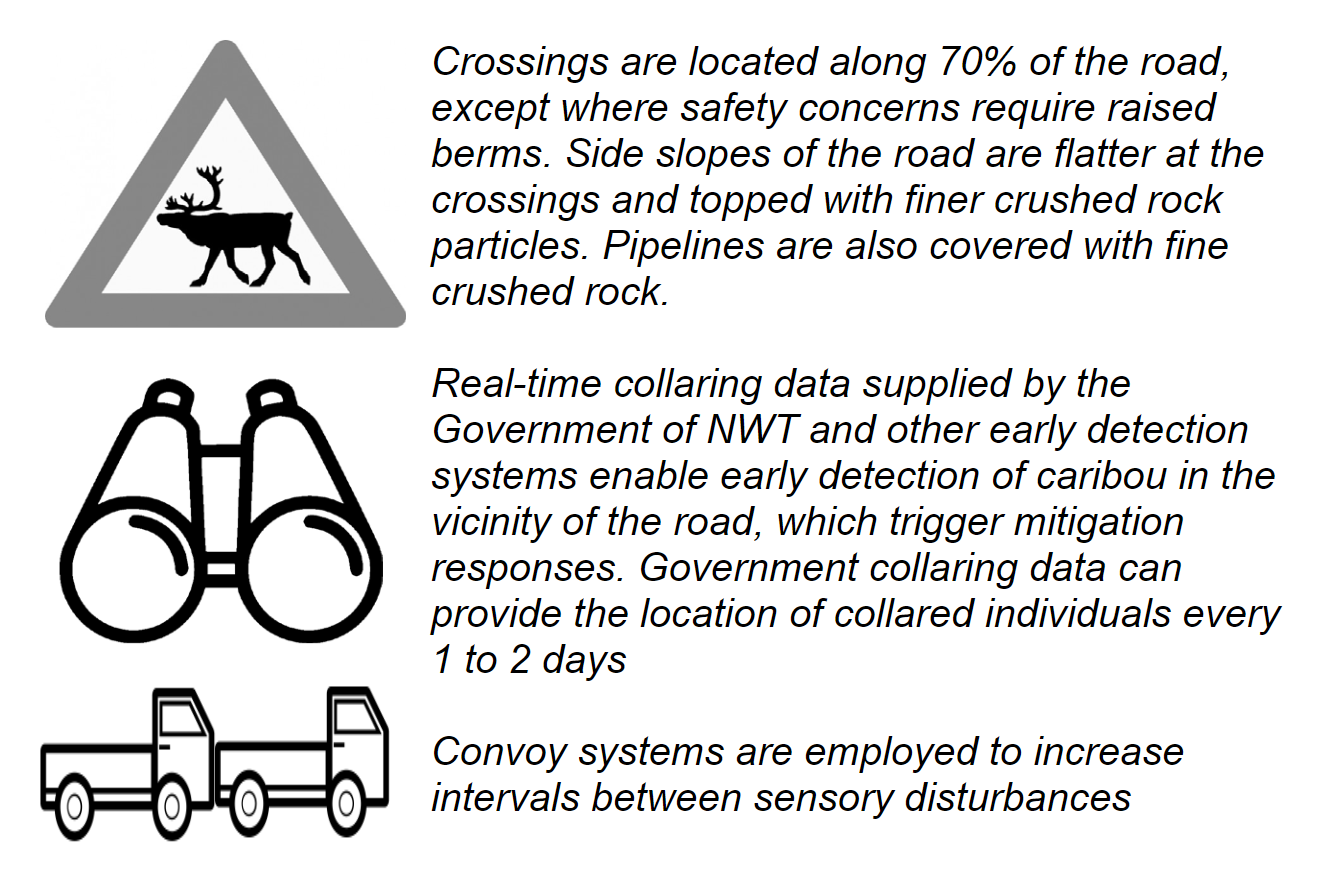

Caribou Management
Strategies
Best Practices for the Mineral Industry
In the summer of 2021, PDAC completed their Caribou Management Strategies: Best Practices for the Mineral Industry study, to analyze the impact of exploration and mining activity on caribou populations and provide solutions to mitigate this impact.
Led by a third party consultant, the research was informed by company case studies, outlining industry leading practices from operations of various sizes and jurisdictions. This project will serve as a tangible resource for PDAC members to understand strategies to mitigate caribou disturbance at each stage of the mineral development sequence, from exploration to closure.

Potential Impacts of Caribou Across the Mineral Development Sequence
Early & Intermediate Exploration
| Activity / Disturbance | Stress Avoidance | Damage to Habitat | Direct Mortality | Improves Predator Efficiency | Attracts Hunters | Attracts Competing Ungulates & Predators |
|---|---|---|---|---|---|---|
| Line cutting | ||||||
| Aircraft use helicopter and fixed-wing | ||||||
| Drilling expanded drill programs in later phases | ||||||
| Camps | ||||||
| Pitting & trenching | ||||||
| Trail construction |
Advanced Exploration & Construction
| Activity / Disturbance | Stress Avoidance | Damage to Habitat | Direct Mortality | Improves Predator Efficiency | Attracts Hunters | Attracts Competing Ungulates & Predators |
|---|---|---|---|---|---|---|
| Stripping | ||||||
| Bulk sampling & hauling | ||||||
| Access road construction | ||||||
| Mine site construction | ||||||
| Transmission lines | ||||||
| Large-scale blasting | ||||||
| Tailing/waste rock facilities |
Production And Closure
| Activity / Disturbance | Stress Avoidance | Damage to Habitat | Direct Mortality | Improves Predator Efficiency | Attracts Hunters | Attracts Competing Ungulates & Predators |
|---|---|---|---|---|---|---|
| Mining | ||||||
| Hauling | ||||||
| Removal of mine facilities |
Activities and impacts listed in Early/Intermediate are amplified in later stages of development.
Mitigation Strategies
Early & Intermediate Exploration

 Line cutting and claim blazing
Line cutting and claim blazing
These activities may result in minimal physical disturbances resulting in caribou stress, and, in the case of line cutting, increase predator movement and search efficiency.
Staff should:
- Use hand tools to avoid sensory disturbances leading to caribou avoidance.
- Avoid unnecessary felling of trees and destruction of valuable forest features.
- When line cutting is unavoidable, cut lines should be kept to 1.5m or less, when possible.

 Ground & aerial surveys
Ground & aerial surveys
Ground surveys that require cords and cables can be harmful to caribou and trigger caribou avoidance.
Staff should:
- Ensure there are no cables or other connectivity left on the forest floor or canopy during prolonged periods of disuse.
- Conduct aerial surveys at high altitudes to mitigate sensory impacts when caribou are present during sensitive seasons, including migration and calving.

 Trail construction
Trail construction
Ground surveys that require cords and cables can be harmful to caribou and trigger caribou avoidance.
Staff should:
- Ensure there are no cables or other connectivity left on the forest floor or canopy during prolonged periods of disuse.
- Conduct aerial surveys at high altitudes to mitigate sensory impacts when caribou are present during sensitive seasons, including migration and calving.
 Intermediate exploration (drilling)
Intermediate exploration (drilling)
Following discovery of a promising mineral deposit, evaluation of the deposit centers on subsurface drilling and the logistical operations and construction activities required to transport drill components and staff to the project site, assemble the drill, and prepare the site. Logistical operations may include air and marine transportation of the drill equipment and possibly hauling the drill to the project site using heavy equipment.
On-site construction activities focus on removal of overburden (e.g., access roads and exploration camp) and improvement of existing infrastructure (e.g., culvert repair) may also be required. Each of the following activities may result in temporary or semi-permanent impacts on caribou:
- Construction and improvement of access roads
- Overland hauling and logistics
- Air re-supply
- Construction and operation of small camps
- Drilling and drill pad construction
- Pitting & trenching
 Planning from a drill program
Planning from a drill program
Prior to commencement of drilling, exploration companies should initiate discussions with potentially impacted Indigenous communities to discuss environmental and economic project impacts as well as impacts to valued heritage resources. In areas with high-value caribou habitat, caribou protection and proposed mitigations will likely be a topic of discussion. Many Indigenous communities may provide information about caribou population health, current and historical range use, and observations about caribou responses to previous projects. As the project becomes more advanced, it is important to engage with different members and organizations within the community such as Chief and Council, community land-use staff, Elders, and hunters and trappers, to obtain as much information about caribou as possible.
Proponents can prepare for early discussions by consulting a range of provincial and territorial materials documenting the location of caribou populations and high-value habitat, including provincial caribou recovery strategies, range plans, and best practices manuals.
If neither TEK, IQ, or desktop research reveals the presence of caribou or high-value habitat, there is no need to pursue caribou-specific project mitigations. However, if the project falls within or is expected to impact seasonal caribou ranges or migration routes, some degree of monitoring and mitigation will likely become necessary. The nature of the mitigations will be contingent upon the scale of the project and number and degree of anticipated impacts.

 Camp construction and operation
Camp construction and operation
Exploration camps in the intermediate stage may damage habitat, attract predators, and lead to caribou avoidance of the area.
Staff should:
- Where possible, build camp structures upon existing clearings
- Predator-proof camps with locked waste containers
- Train camp staff to avoid caribou found in the vicinity of the project and record and report any caribou sightings
- Restore cleared areas when drill pads are no longer necessary
- Avoid unnecessary idling of drills

 Overland hauling and logistics
Overland hauling and logistics
Vehicular traffic on trails and small access roads during intermediate exploration will likely be extremely limited and the potential for collisions with caribou remote. However, traffic along these routes can trigger caribou avoidance. In areas containing high-value caribou habitat.
Staff should:
- Learn about caribou uses during sensitive seasons
- Where possible, limit traffic along these corridors in sensitive seasons

 Air re-supply
Air re-supply
In some remote locations without road access, helicopters and fixed-wing aircraft are needed to transport essential equipment, such as drill components, staff, and supplies to project sites. Noise from aircrafts can trigger caribou avoidance. When possible, i.e., without compromising human safety.
Staff should:
- Instruct pilots not to land or take off when caribou are present and turn off propellers as soon as possible after landing
- Gently guide caribou out of the immediate area without use of vehicles or machinery
Advanced Exploration & Construction
Advanced exploration entails an amplification of the activities undertaken in the intermediate exploration phase, including more drills, larger camps, and more staff.
Cutovers increase in size and number, leading to greater area disturbances. In addition to continuation and adaptation to a larger scale of the management activities described in the previous section, Caribou management in the advanced exploration phase should introduce more rigorous monitoring protocols to detect caribou presence and observe their interactions with the project site, especially in sensitive seasons.
In addition to strengthening existing mitigations, increased monitoring can help proponents assemble information to submit to regulators should the project advance to mine construction and operation. It is in this phase that planning for mine construction, and mitigations to be adopted during the operational phase of the mine, will be undertaken.


Measures adopted by Dominion to mitigate impacts to Bathurst Caribou along its Jay Road.
Access / Haul Roads
Planning around roads and transportation networks takes on a new dimension during advanced exploration. In this phase, bulk sampling of large quantities of ore brings transportation infrastructure requirements that cannot always be met with access trails used during earlier stages of exploration.
In remote areas, construction of a permanent road or transportation network is required to facilitate this activity. In addition, it is in this phase that planning for mine development and operation takes place, including any plans to mitigate impacts to caribou populations. It is likely that in many locations, particularly in arctic and remote regions, roads will become a key focus of environmental assessments.
Use of both TEK, IQ, and available western scientific data will be crucial to development of appropriate strategies. Figure 1 illustrates standard mitigations that can be employed to manage impacts to caribou populations after a suitable route has been identified. In order to proceed in a timely manner through Indigenous consultation activities and environmental assessments, the planned route should reflect analysis of TEK, IQ, and satellite collaring and landcover data provided by provincial and territorial governments, where available.
Case Study
Agnico Eagle’s monitoring and mitigation measures on its all-weather access road between the Meliadine Mine and Rankin Inlet, Nunavut are influenced by spring and fall caribou migrations. Mitigation triggers involve consultations with the Kivalliq Inuit Association (KIA), Hunters and Trappers Organizations (HTOs), and the Government of Nunavut (GN). Agnico Eagle’s road monitoring and mitigation plan is summarized in Table 2.
Caribou management and monitoring at Agnico Eagle’s Meadowbank-Whale Tail operations are resourced by an Environmental Superintendent along with approximately 4-6 on-site technicians during migration, including contract staff from the Baker Lake HTO, to monitor caribou distribution and interactions with the company’s operations. During migration, the KIA has 1-2 representatives working either on site or in Baker Lake to monitor and provide advice to the caribou management program.
Production and closure can define a different set of considerations for caribou disturbance mitigations. More detail on these practices can be extracted from our case study below.
| Response level | # of Caribou detected (distance km) | Monitoring Response | Mitigation | Duration |
|---|---|---|---|---|
| 1. | 1 (within 50km) (collaring data) |
|
| 5 days |
| 2. | 25 (4km) |
|
| 5 days |
| 12 (4km) during calving | 10 days (Fall, Spring migrations) | |||
| 3. (Winter & Summer) | 25 (1.5km) | Continue Level 2 monitoring |
| 5 days |
| 3. Sensitive Seasons (Fall & Spring Migration, Calving) | 12 (5km) during calving |
|
